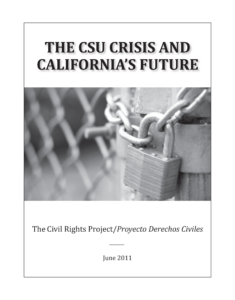PART TWO of the series is comprised of two original studies analyzing the impact of fiscal cutbacks on faculty in the CSU higher education system.
Faculty Under Siege: Demoralization and Educational Decline, by Gary Orfield
In Faculty Under Siege, data from an electronic survey of over 400 hundred faculty members at multiple CSU campuses shows that CSU faculty are severely impacted by budget cuts as the sizes of their classrooms increase, and resources and support are cut away. What they can offer their students is declining given that teaching loads are too big and support too weak. Faculty worry that they cannot teach students to write when they have 60 and 70 in a class. This study offers new data showing specific shifts in workload and sources of stress before and after the budget cuts. The report finds that many professors in the CSU system feel that the cutbacks already implemented, coupled with the substantial cuts projected, put the quality of a CSU education in a rapid downward spiral. Not only is access restricted but quality of instruction is also being eroded.
Executive Summary
The fundamental asset of a university is its faculty. Without faculty working with students, the university is just a set of buildings. The faculty design and teach the courses, keep the educational program updated, and work with students to help them gain the skills and knowledge they need to prepare for their careers or professional education. The quality of faculty is very directly linked to the quality of a student’s education and the value of the degree. The research released in these two new studies from the Civil Rights Project shows that the budget cutbacks at the California State University system are already reducing the quality of education faculty can offer students. The CSU now faces large additional cuts.
Faculty Under Siege: Demoralization and Educational Decline, is based on a survey of more than four hundred faculty across the CSU system and it shows that the main sources of stress that appear to affect job satisfaction and the quality of teaching are increased class sizes and teaching loads, a lack of personal time, not receiving support and supplies from the system, working with underprepared students, and advising an increasing number of students. This web-based survey collected data on 424 faculty; 76% are full-time employees of their institution, and the majority of respondents teach at only one campus. In addition, 47% had tenure at the time of the survey, with an additional 22% on tenure track.
Faculty Under Siege Key Findings:
• 96% of faculty reported that institutional budget cuts are a major source of stress. Half of the faculty reported a reduction in resources and supplies, with increases in class sizes and teaching loads.
• Greater than a fifth of faculty are teaching more courses and a third are spending more time for classroom preparation. In addition, 43% of faculty reported a decrease in research and scholarly writing due to a lack of time.
• Since the budget cuts, many faculty reported decreased expectations of students due to the increased teaching loads and lack of time. Nearly 35% report a decreased expectation of students revising papers to improve writing. A sixth of faculty say they also see fewer questions answered in class.
• Professional demoralization is severe. 63% of faculty said they have considered leaving their institution. A third of faculty said they have considered early retirement, and 48% have considered leaving the academic profession altogether.
• Over 80% of faculty reported several sources of stress, including personal finances and a lack of personal time. Nearly 85% said working with underprepared students is also a major source of stress.
The Worst of Times: Faculty Productivity and Job Satisfaction, the second new study, examined the impact of budget cuts in the CSU system on the productivity and job satisfaction of tenured/tenure-track faculty at a Northern California campus (called NSCU to preserve anonymity). Faculty reported a profoundly negative impact due to excessive teaching loads, furlough-based salary cuts, larger class sizes, increased student contact, decreased compensation, lack of time for research, and decreases in resources available. They saw the budget cuts harming instruction. The stresses of workload increase, productivity decrease, job dissatisfaction, and the resulting harm to students emerged as the four main themes of this study.
The Worst of Times Key Findings:
• The majority of faculty reported feeling overwhelmed by the increased class sizes and decreased support, both of which harmed teaching effectiveness.
• Within a 2-year period, NSCU experienced an 18% decline in the number of instructional faculty. The participants of the study identified this as a major source of stress and job dissatisfaction.
• The majority of faculty reported the lack of time to do research, as well as decreased resources and support for scholarship as a common concern leading to job dissatisfaction.
• Nearly all CSU employees had experienced furloughs, which amounted to approximately a 10% cut in pay. Many were struggling to make ends meet.
• Lowered morale due to salary cuts, increased workload, and lack of support and resources made them think about leaving the University.
Despite the findings in the survey and interview data, faculty reported a strong commitment to teaching and their students. The report suggests lack of improvement in faculty support and working conditions as detrimental to the long-term health of the University. From the faculty perspective, the system was stretched very thin long before the cuts which came last summer and fall; students already were at risk before the recent tuition increases and will experience further setbacks as more cuts loom.
Read more about why we undertook these studies: THE CSU CRISIS AND CALIFORNIA’S FUTURE
For a brief summary of each paper in the series or to download the complete manuscript, see The CSU Crisis and California’s Future: Paper Titles, Authors and Abstracts.
In compliance with the UC Open Access Policy, this report has been made available on eScholarship:






